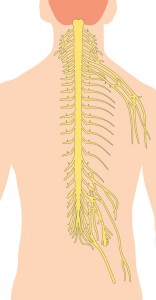Stenosis is the medical term doctors use to describe abnormal narrowing, such as can occur in a blood vessel or other tube-like structure. In the spine, there are primarily two tube-like structures.
- Neuroforamen: naturally created pathways at the left and right sides between two vertebrae.
- Spinal canal: it contains the spinal cord, which becomes the cauda equina in the low back. The cauda equina is a bunch of individual nerve fibers that resemble the tail of a horse. The vertebral bones (bodies, arches, pedicles) create this natural vertical hollow to hold and protect the spinal cord and cauda equina.
Types of spinal stenosis
- Cervical (neck) and lumbar (low back)
- Foraminal stenosis occurs when something compresses a nerve exiting the spinal column through the neuroforamen.
- Central canal stenosis occurs when something compresses nerves in the spinal canal.
- Some people develop both types of cervical and/or lumbar spinal stenosis.
Is pain tolerable or intense?
Are there other symptoms?
Why see a spine specialist for a diagnosis?
What are the treatment options?
Causes
Although some people are born with spinal stenosis (called congenital spinal stenosis), most times, it develops after age 50. Stenosis may progress incidental to naturally growing older and spinal wear and tear.

Some patients have a history of back injury or trauma. The accident may have happened months or years before the onset of stenotic symptoms.
Different disorders can cause nerve compression, such as:
- Spinal ligaments thicken, buckle*
- Osteophytes (bony overgrowths)
- Bulging or herniated discs
- Degenerative disc disease
*The ligamentum flavum is a spinal ligament that, when it thickens, can buckle and compress spinal nerve structures.
Pain and other symptoms
Some people have no symptoms; they are asymptomatic. However, spinal stenosis usually is progressive, which means symptoms gradually develop and may worsen. Pain and symptoms may spread into another part of the body. This is called radicular pain or radiculopathy.
| Cervical Spinal Stenosis | Lumbar Spinal Stenosis |
| Neck pain, mild to intense | Low back pain, mild to intense |
| Upper extremity pain, weakness | Buttock, leg pain and/or weakness |
| Hand clumsiness | Difficult and painful to walk, stand, bend backwards |
| Neck, Shoulders, Arms, Hands | Low Back, Buttocks, Legs |
| Sensations: burning, tingling, numbness, pins and needles | Sensations: burning, tingling, numbness, pins and needles |
| In severe cases, bladder and bowel dysfunction | In severe cases, bladder and bowel dysfunction |
| Rare, loss of function or paraplegia | Rare, loss of function or paraplegia |
Accurate diagnosis
Consult an expert about your neck or back pain, pre-existing spinal stenosis or changing spinal disorder. An accurate diagnosis is essential to an effective and successful treatment plan.
Your medical history and physical and neurological examinations are very important. You and your doctor discuss your symptoms, their severity, and treatments tried. The doctor tests your reflexes and evaluates you for muscle weakness, loss of feeling, and signs of neurological injury.
Diagnostic testing may include x-rays, CT or MRI scans, or myelography to enhance the surgeon’s examination of your spine.
Treatment options
Non-surgical treatment often helps to relieve pain and symptoms. Your doctor may combine two or more therapies to maximize the success of your treatment.
Non-surgical treatments include:
- Non-steroidal anti-inflammatory drugs (NSAIDs)
- Pain medication (a narcotic, painkiller)
- Muscle relaxing medication
- Spinal injection
- Short-term bracing supports the spine, may help relieve pain
- Physical therapy
- Acupuncture
When your surgeon may discuss surgical treatment
- Spinal instability
- Neurologic dysfunction
- Pain and symptoms are unrelenting
- Non-operative treatment fails and pain persists
Surgical treatment
The goal of surgery is to decompress—take pressure off—the nerve roots and/or spinal canal. Decompression is a surgical procedure that involves trimming or removing whatever is causing compression. Many procedures can be performed using minimally invasive surgical techniques and instruments. Your surgeon will discuss the most appropriate procedure for you and help you understand the possible risks and benefits.
Decompressive laminectomy removes (ectomy) the lamina to create more space around spinal nerves and/or the spinal canal. The procedure is called a decompressive laminotomy when part (otomy) of the lamina is removed.
Laminoplasty expands the size of the spinal canal by lifting one side of the lamina. This procedure retains spinal stability and reduces the need for fusion.
Foraminotomy enlarges the size of the neuroforamen to decompress nerves.
Instrumentation and fusion stabilize the spine and may be combined with another procedure. Instrumentation utilizes implants such as interbody devices, screws, rods, or plates. Bone graft is packed around the instrumentation to help the spine heal and fuse two or more vertebrae together.
Next steps
We hope this information about spinal stenosis has answered your immediate questions. Remember, your doctor is your most valuable source to answer your questions about symptoms and your healthcare.





